Changhao Li
You Only Evaluate Once: A Tree-based Rerank Method at Meituan
Aug 20, 2025



Abstract:Reranking plays a crucial role in modern recommender systems by capturing the mutual influences within the list. Due to the inherent challenges of combinatorial search spaces, most methods adopt a two-stage search paradigm: a simple General Search Unit (GSU) efficiently reduces the candidate space, and an Exact Search Unit (ESU) effectively selects the optimal sequence. These methods essentially involve making trade-offs between effectiveness and efficiency, while suffering from a severe \textbf{inconsistency problem}, that is, the GSU often misses high-value lists from ESU. To address this problem, we propose YOLOR, a one-stage reranking method that removes the GSU while retaining only the ESU. Specifically, YOLOR includes: (1) a Tree-based Context Extraction Module (TCEM) that hierarchically aggregates multi-scale contextual features to achieve "list-level effectiveness", and (2) a Context Cache Module (CCM) that enables efficient feature reuse across candidate permutations to achieve "permutation-level efficiency". Extensive experiments across public and industry datasets validate YOLOR's performance, and we have successfully deployed YOLOR on the Meituan food delivery platform.
Task-Specific Zero-shot Quantization-Aware Training for Object Detection
Jul 22, 2025Abstract:Quantization is a key technique to reduce network size and computational complexity by representing the network parameters with a lower precision. Traditional quantization methods rely on access to original training data, which is often restricted due to privacy concerns or security challenges. Zero-shot Quantization (ZSQ) addresses this by using synthetic data generated from pre-trained models, eliminating the need for real training data. Recently, ZSQ has been extended to object detection. However, existing methods use unlabeled task-agnostic synthetic images that lack the specific information required for object detection, leading to suboptimal performance. In this paper, we propose a novel task-specific ZSQ framework for object detection networks, which consists of two main stages. First, we introduce a bounding box and category sampling strategy to synthesize a task-specific calibration set from the pre-trained network, reconstructing object locations, sizes, and category distributions without any prior knowledge. Second, we integrate task-specific training into the knowledge distillation process to restore the performance of quantized detection networks. Extensive experiments conducted on the MS-COCO and Pascal VOC datasets demonstrate the efficiency and state-of-the-art performance of our method. Our code is publicly available at: https://github.com/DFQ-Dojo/dfq-toolkit .
MLE-Dojo: Interactive Environments for Empowering LLM Agents in Machine Learning Engineering
May 12, 2025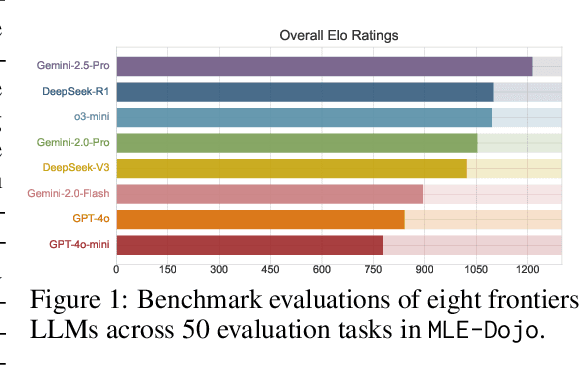



Abstract:We introduce MLE-Dojo, a Gym-style framework for systematically reinforcement learning, evaluating, and improving autonomous large language model (LLM) agents in iterative machine learning engineering (MLE) workflows. Unlike existing benchmarks that primarily rely on static datasets or single-attempt evaluations, MLE-Dojo provides an interactive environment enabling agents to iteratively experiment, debug, and refine solutions through structured feedback loops. Built upon 200+ real-world Kaggle challenges, MLE-Dojo covers diverse, open-ended MLE tasks carefully curated to reflect realistic engineering scenarios such as data processing, architecture search, hyperparameter tuning, and code debugging. Its fully executable environment supports comprehensive agent training via both supervised fine-tuning and reinforcement learning, facilitating iterative experimentation, realistic data sampling, and real-time outcome verification. Extensive evaluations of eight frontier LLMs reveal that while current models achieve meaningful iterative improvements, they still exhibit significant limitations in autonomously generating long-horizon solutions and efficiently resolving complex errors. Furthermore, MLE-Dojo's flexible and extensible architecture seamlessly integrates diverse data sources, tools, and evaluation protocols, uniquely enabling model-based agent tuning and promoting interoperability, scalability, and reproducibility. We open-source our framework and benchmarks to foster community-driven innovation towards next-generation MLE agents.
MASH: Masked Anchored SpHerical Distances for 3D Shape Representation and Generation
Apr 12, 2025

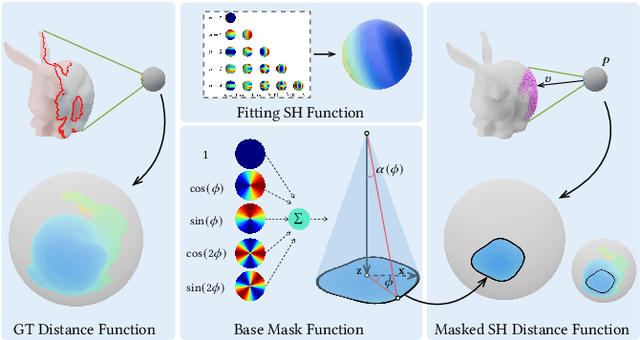

Abstract:We introduce Masked Anchored SpHerical Distances (MASH), a novel multi-view and parametrized representation of 3D shapes. Inspired by multi-view geometry and motivated by the importance of perceptual shape understanding for learning 3D shapes, MASH represents a 3D shape as a collection of observable local surface patches, each defined by a spherical distance function emanating from an anchor point. We further leverage the compactness of spherical harmonics to encode the MASH functions, combined with a generalized view cone with a parameterized base that masks the spatial extent of the spherical function to attain locality. We develop a differentiable optimization algorithm capable of converting any point cloud into a MASH representation accurately approximating ground-truth surfaces with arbitrary geometry and topology. Extensive experiments demonstrate that MASH is versatile for multiple applications including surface reconstruction, shape generation, completion, and blending, achieving superior performance thanks to its unique representation encompassing both implicit and explicit features.
Matryoshka: Learning to Drive Black-Box LLMs with LLMs
Oct 28, 2024Abstract:Despite the impressive generative abilities of black-box large language models (LLMs), their inherent opacity hinders further advancements in capabilities such as reasoning, planning, and personalization. Existing works aim to enhance LLM capabilities via domain-specific adaptation or in-context learning, which require additional training on accessible model parameters, an infeasible option for black-box LLMs. To address this challenge, we introduce Matryoshika, a lightweight white-box LLM controller that guides a large-scale black-box LLM generator by decomposing complex tasks into a series of intermediate outputs. Specifically, we consider the black-box LLM as an environment, with Matryoshika serving as a policy to provide intermediate guidance through prompts for driving the black-box LLM. Matryoshika is trained to pivot the outputs of the black-box LLM aligning with preferences during iterative interaction, which enables controllable multi-turn generation and self-improvement in optimizing intermediate guidance. Empirical evaluations on three diverse tasks demonstrate that Matryoshika effectively enhances the capabilities of black-box LLMs in complex, long-horizon tasks, including reasoning, planning, and personalization. By leveraging this pioneering controller-generator framework to mitigate dependence on model parameters, Matryoshika provides a transparent and practical solution for improving black-box LLMs through controllable multi-turn generation using white-box LLMs.
PruningBench: A Comprehensive Benchmark of Structural Pruning
Jun 18, 2024



Abstract:Structural pruning has emerged as a promising approach for producing more efficient models. Nevertheless, the community suffers from a lack of standardized benchmarks and metrics, leaving the progress in this area not fully comprehended. To fill this gap, we present the first comprehensive benchmark, termed \textit{PruningBench}, for structural pruning. PruningBench showcases the following three characteristics: 1) PruningBench employs a unified and consistent framework for evaluating the effectiveness of diverse structural pruning techniques; 2) PruningBench systematically evaluates 16 existing pruning methods, encompassing a wide array of models (e.g., CNNs and ViTs) and tasks (e.g., classification and detection); 3) PruningBench provides easily implementable interfaces to facilitate the implementation of future pruning methods, and enables the subsequent researchers to incorporate their work into our leaderboards. We provide an online pruning platform http://pruning.vipazoo.cn for customizing pruning tasks and reproducing all results in this paper. Codes will be made publicly available.
QC-Forest: a Classical-Quantum Algorithm to Provably Speedup Retraining of Random Forest
Jun 17, 2024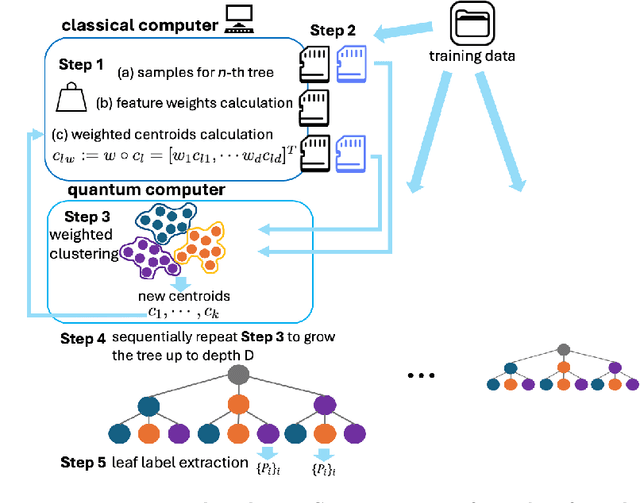

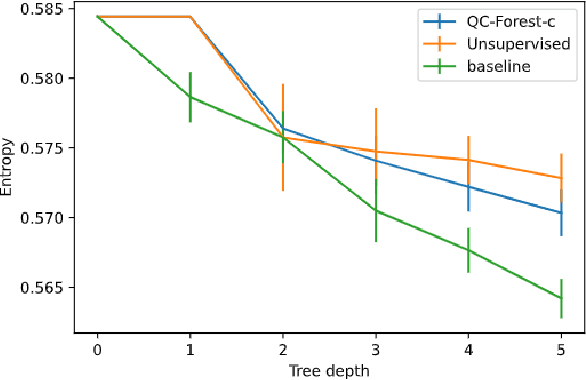
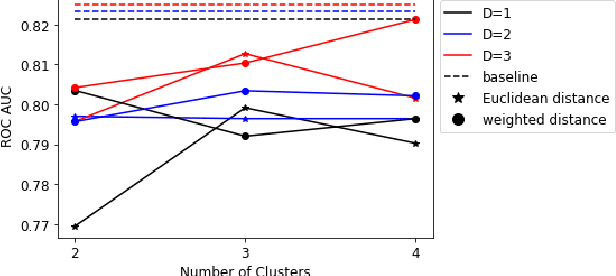
Abstract:Random Forest (RF) is a popular tree-ensemble method for supervised learning, prized for its ease of use and flexibility. Online RF models require to account for new training data to maintain model accuracy. This is particularly important in applications were data is periodically and sequentially generated over time in data streams, such as auto-driving systems, and credit card payments. In this setting, performing periodic model retraining with the old and new data accumulated is beneficial as it fully captures possible drifts in the data distribution over time. However, this is unpractical with state-of-the-art classical algorithms for RF as they scale linearly with the accumulated number of samples. We propose QC-Forest, a classical-quantum algorithm designed to time-efficiently retrain RF models in the streaming setting for multi-class classification and regression, achieving a runtime poly-logarithmic in the total number of accumulated samples. QC-Forest leverages Des-q, a quantum algorithm for single tree construction and retraining proposed by Kumar et al. by expanding to multi-class classification, as the original proposal was limited to binary classes, and introducing an exact classical method to replace an underlying quantum subroutine incurring a finite error, while maintaining the same poly-logarithmic dependence. Finally, we showcase that QC-Forest achieves competitive accuracy in comparison to state-of-the-art RF methods on widely used benchmark datasets with up to 80,000 samples, while significantly speeding up the model retrain.
CoNav: A Benchmark for Human-Centered Collaborative Navigation
Jun 04, 2024Abstract:Human-robot collaboration, in which the robot intelligently assists the human with the upcoming task, is an appealing objective. To achieve this goal, the agent needs to be equipped with a fundamental collaborative navigation ability, where the agent should reason human intention by observing human activities and then navigate to the human's intended destination in advance of the human. However, this vital ability has not been well studied in previous literature. To fill this gap, we propose a collaborative navigation (CoNav) benchmark. Our CoNav tackles the critical challenge of constructing a 3D navigation environment with realistic and diverse human activities. To achieve this, we design a novel LLM-based humanoid animation generation framework, which is conditioned on both text descriptions and environmental context. The generated humanoid trajectory obeys the environmental context and can be easily integrated into popular simulators. We empirically find that the existing navigation methods struggle in CoNav task since they neglect the perception of human intention. To solve this problem, we propose an intention-aware agent for reasoning both long-term and short-term human intention. The agent predicts navigation action based on the predicted intention and panoramic observation. The emergent agent behavior including observing humans, avoiding human collision, and navigation reveals the efficiency of the proposed datasets and agents.
Prospects of Privacy Advantage in Quantum Machine Learning
May 15, 2024



Abstract:Ensuring data privacy in machine learning models is critical, particularly in distributed settings where model gradients are typically shared among multiple parties to allow collaborative learning. Motivated by the increasing success of recovering input data from the gradients of classical models, this study addresses a central question: How hard is it to recover the input data from the gradients of quantum machine learning models? Focusing on variational quantum circuits (VQC) as learning models, we uncover the crucial role played by the dynamical Lie algebra (DLA) of the VQC ansatz in determining privacy vulnerabilities. While the DLA has previously been linked to the classical simulatability and trainability of VQC models, this work, for the first time, establishes its connection to the privacy of VQC models. In particular, we show that properties conducive to the trainability of VQCs, such as a polynomial-sized DLA, also facilitate the extraction of detailed snapshots of the input. We term this a weak privacy breach, as the snapshots enable training VQC models for distinct learning tasks without direct access to the original input. Further, we investigate the conditions for a strong privacy breach where the original input data can be recovered from these snapshots by classical or quantum-assisted polynomial time methods. We establish conditions on the encoding map such as classical simulatability, overlap with DLA basis, and its Fourier frequency characteristics that enable such a privacy breach of VQC models. Our findings thus play a crucial role in detailing the prospects of quantum privacy advantage by guiding the requirements for designing quantum machine learning models that balance trainability with robust privacy protection.
Entire Chain Uplift Modeling with Context-Enhanced Learning for Intelligent Marketing
Feb 04, 2024



Abstract:Uplift modeling, vital in online marketing, seeks to accurately measure the impact of various strategies, such as coupons or discounts, on different users by predicting the Individual Treatment Effect (ITE). In an e-commerce setting, user behavior follows a defined sequential chain, including impression, click, and conversion. Marketing strategies exert varied uplift effects at each stage within this chain, impacting metrics like click-through and conversion rate. Despite its utility, existing research has neglected to consider the inter-task across all stages impacts within a specific treatment and has insufficiently utilized the treatment information, potentially introducing substantial bias into subsequent marketing decisions. We identify these two issues as the chain-bias problem and the treatment-unadaptive problem. This paper introduces the Entire Chain UPlift method with context-enhanced learning (ECUP), devised to tackle these issues. ECUP consists of two primary components: 1) the Entire Chain-Enhanced Network, which utilizes user behavior patterns to estimate ITE throughout the entire chain space, models the various impacts of treatments on each task, and integrates task prior information to enhance context awareness across all stages, capturing the impact of treatment on different tasks, and 2) the Treatment-Enhanced Network, which facilitates fine-grained treatment modeling through bit-level feature interactions, thereby enabling adaptive feature adjustment. Extensive experiments on public and industrial datasets validate ECUPs effectiveness. Moreover, ECUP has been deployed on the Meituan food delivery platform, serving millions of daily active users, with the related dataset released for future research.
 Add to Chrome
Add to Chrome Add to Firefox
Add to Firefox Add to Edge
Add to Edge